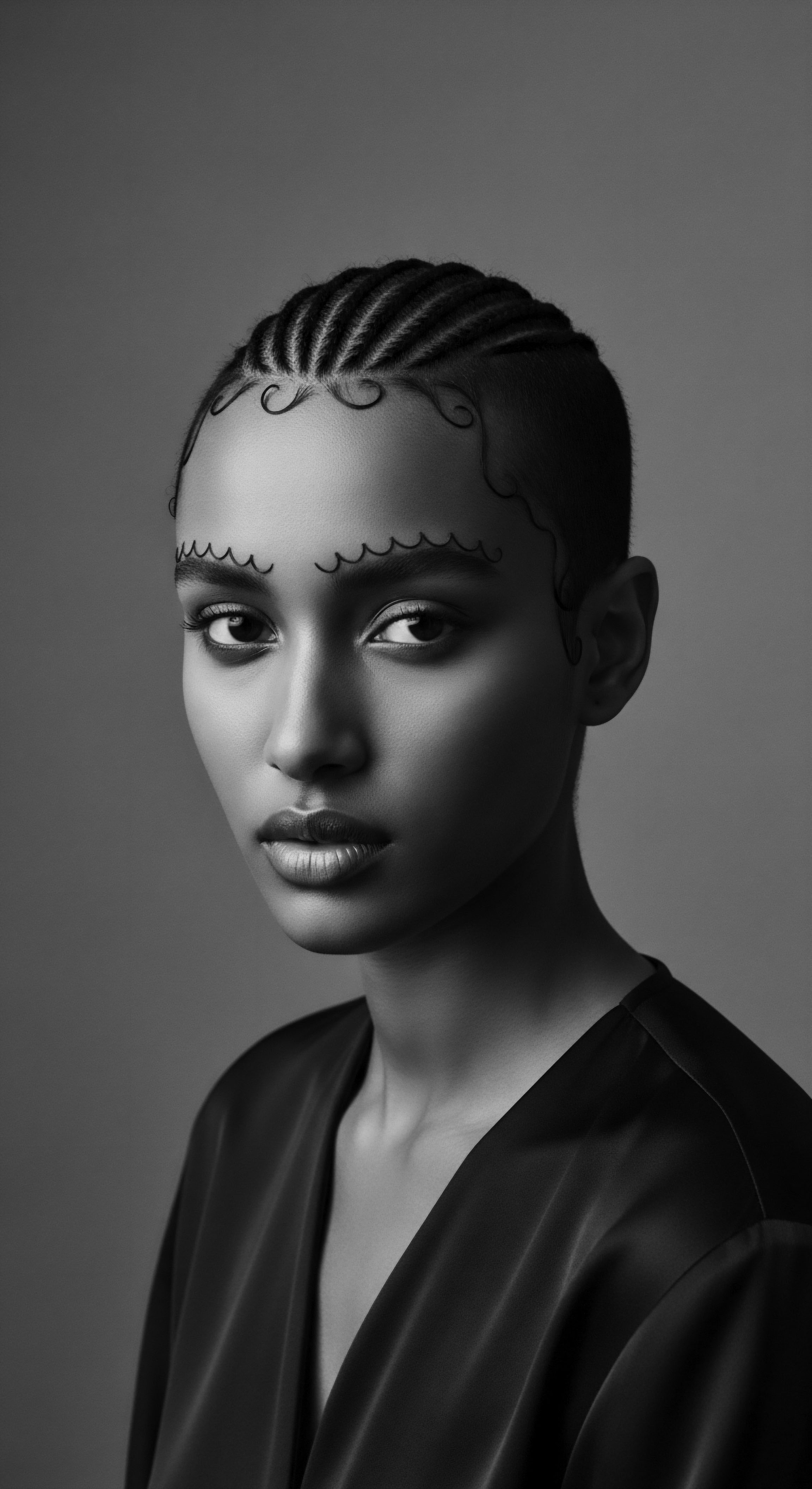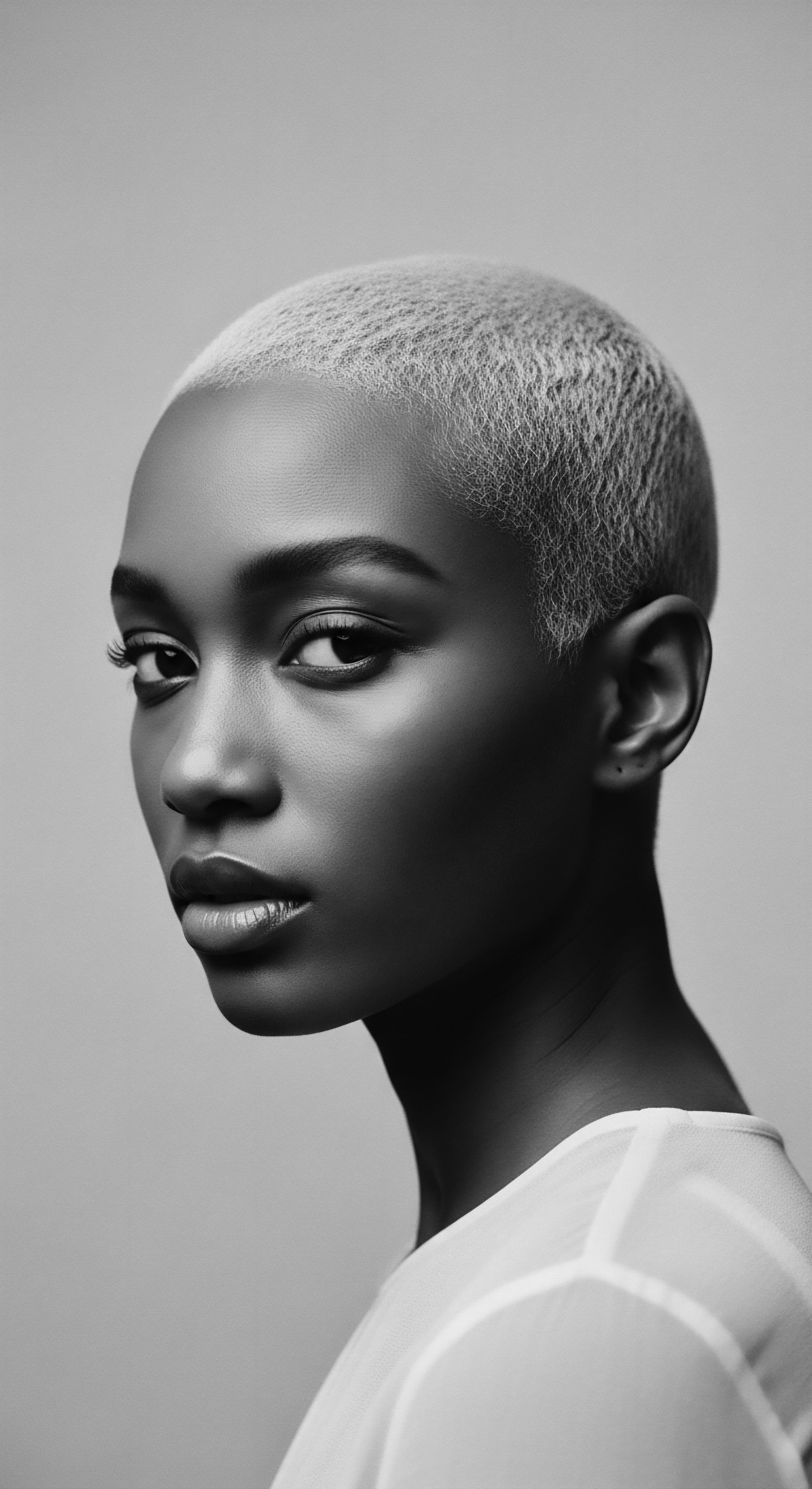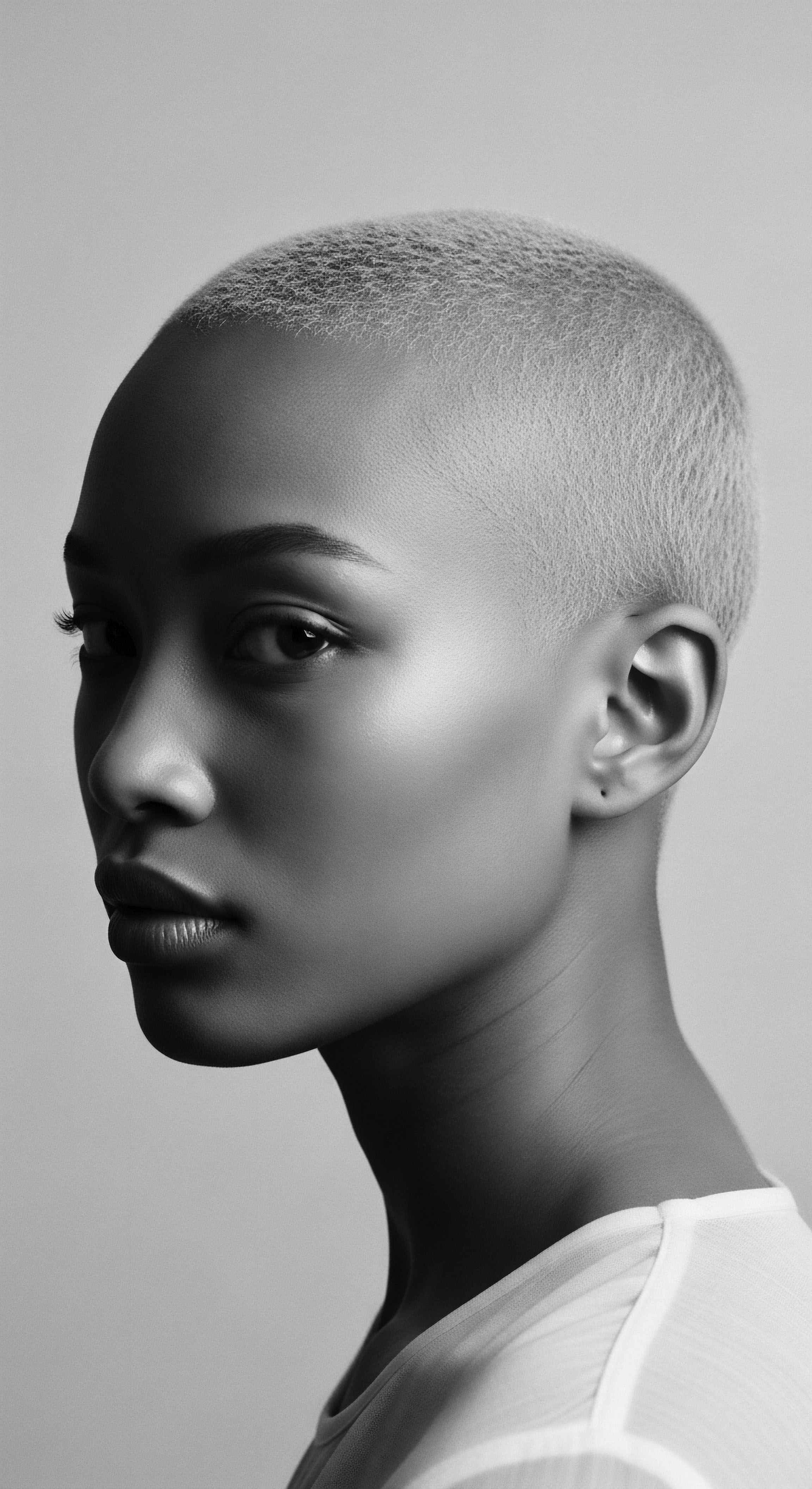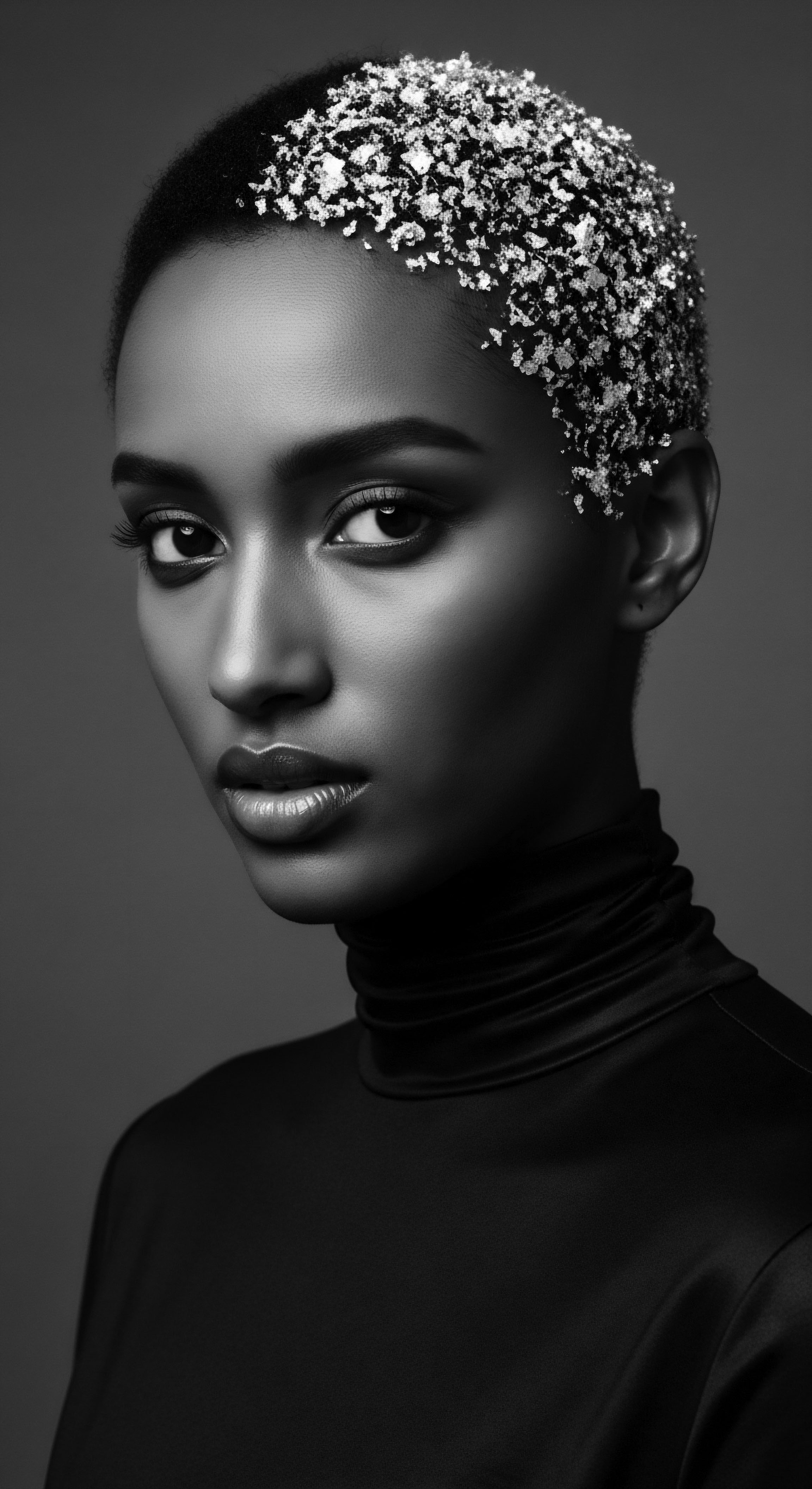
Roots
The question of whether head wraps shielded textured hair from the caprices of climate is one that takes us on a journey through time, a journey deeply etched into the very fibers of Black and mixed-race heritage. For those whose strands coil and spiral with an innate vitality, hair has always been more than mere adornment. It stands as a living archive, a chronicle of resilience, ingenuity, and profound cultural memory.
To ask about head wraps and climate is to seek not just a functional answer, but to touch upon generations of wisdom, a silent conversation between our ancestors and the world around them. Their practices, born of necessity and elevated to artistry, offer insights into elemental biology and ancestral care.

Hair Anatomy and the Ancestral Shield
Textured hair, with its unique elliptical follicle shape and varied curl patterns, possesses inherent characteristics that both bless and challenge it in diverse environmental conditions. Its structure, often featuring more cuticle layers than straighter hair, provides a degree of natural protection. Yet, these very coils and turns mean that natural oils from the scalp travel down the hair shaft with greater difficulty, leading to a tendency toward dryness.
Environmental factors—scorching sun, arid winds, even extreme cold—can exacerbate this dryness, leading to brittleness and breakage. It was against these elemental forces that ancestral communities in Africa began to craft coverings for their crowns.
Head wraps served as a vital shield, protecting textured hair from harsh climates while preserving its delicate moisture balance.
Consider the sun-drenched landscapes of West Africa, where head wraps originated as early as 3000 BCE. Here, the sun’s intense ultraviolet radiation and the persistent dust presented constant threats to hair health. Early wraps, made from locally woven textiles, provided a physical barrier.
They acted as a second skin for the scalp and hair, deflecting direct sunlight and minimizing exposure to particulate matter that could dry out strands or irritate the scalp. The thermal insulation properties of certain fabrics, like cotton, were naturally harnessed to keep the head cool in intense heat and offer warmth in cooler conditions.

Traditional Classifications and Hair’s Environmental Dialogue
While modern science offers classifications like 3A to 4C, ancestral communities understood hair through its lived interaction with the world. Hair was categorized by its health, its response to moisture, and its appearance after daily life under various skies. The tradition of head wrapping was not a singular act but a dynamic practice, adapting to immediate climatic demands.
For instance, in regions with high humidity, lighter, breathable fabrics might have been favored to allow airflow, while in drier, windier locales, denser wraps could offer more comprehensive coverage against moisture loss. This adaptive wisdom reflects a profound ecological literacy, where cultural practices were inextricably linked to environmental realities.
- Gele ❉ Nigerian ceremonial head wraps, often elaborate, signifying social status and special occasions, but also providing a substantial barrier against the elements.
- Doek ❉ Found in Southern Africa, such as South Africa and Zimbabwe, representing cultural pride and womanhood, used for protection and daily wear.
- Duku ❉ Common in Ghana and Malawi, often a more utilitarian wrap, used for daily chores and protection from sun and dirt.

The Lexicon of Hair’s Protection
The language surrounding textured hair in ancestral traditions often spoke to its vulnerability and the need for care. Terms describing hair damage might have been linked to environmental exposure, while words associated with healthy hair would relate to its protected state. The very existence of varied names for head wraps across African cultures—from the Yoruba’s gele to the Ghanaian duku—underscores their integral role in daily life and hair care.
These terms are not just labels; they are linguistic markers of a heritage that understood protection as fundamental to beauty and wellbeing. The deliberate act of covering hair was a recognized strategy to preserve its natural oils, prevent tangles, and reduce environmental wear.
| Ancestral Hair Care Methods Head wraps for sun and dust shielding. |
| Modern Scientific Parallels UV protection for hair, reduction of particulate accumulation on hair shafts. |
| Ancestral Hair Care Methods Covering hair to retain moisture, particularly overnight. |
| Modern Scientific Parallels Using smooth fabrics like silk or satin to minimize friction and prevent moisture loss. |
| Ancestral Hair Care Methods Utilizing natural fibers like cotton for breathability and absorption. |
| Modern Scientific Parallels Cotton's moisture-wicking properties for sweat absorption and scalp health. |
| Ancestral Hair Care Methods The protective functions of head wraps, understood through ancestral wisdom, find validation in contemporary scientific knowledge of hair health. |

Ritual
The head wrap, in its many forms and functions, stands as a testament to the art and science of textured hair styling across generations. Its presence in daily rituals and grand transformations speaks volumes about the historical and cultural forces that shaped Black and mixed-race hair practices. More than a simple covering, it became a tool, a canvas, and a symbol intertwined with personal and communal identity. The deep connection to heritage is apparent in how these coverings moved from practical necessity to profound cultural statements, influencing styling techniques and tools throughout history.

Protective Styling and Ancient Roots
From the intricate braids of West Africa to the coiled artistry of the Caribbean, protective styling has long been a hallmark of textured hair care. Head wraps historically augmented these styles, providing an additional layer of preservation against environmental aggressors. During times of rigorous labor, whether in the sun-drenched fields of ancestral lands or the oppressive plantations of the Americas, head wraps served to keep hair tidy, reduce exposure to dirt and sweat, and guard against tangling and breakage. This was a practice of survival, a way to maintain hair health when conditions were harsh.
The head wrap, a garment of utility and beauty, protected intricate styles while affirming cultural presence amidst adversity.
The transition of head wraps from their utilitarian origins in Africa to their forced use during enslavement in the Americas offers a striking example of their evolution. In the antebellum South, laws like the Louisiana Tignon law of 1784 compelled Black women to cover their hair, a deliberate act meant to suppress their perceived attractiveness and social standing. Yet, these women, with an enduring spirit, transformed the imposed wraps into expressions of artistry and defiance. They adorned their tignons with vibrant colors and elaborate ties, turning a symbol of subjugation into one of resistance and beauty.
This historical example underscores the powerful interplay between environmental, social, and aesthetic dimensions of head wraps. (Byrd & Tharps, 2001, p. 55)

Styling Techniques and Coverings
The very act of head wrapping became a styling technique in itself, evolving into a skilled art form. Different wrapping methods conveyed meaning, signaled marital status, wealth, or tribal affiliation in various African societies. These techniques were often passed down through matriarchal lines, embodying a living heritage of hair artistry. The materials chosen—cotton, silk, or locally woven textiles—influenced not only the visual statement but also the practical benefits for the hair underneath.
Silk and satin, for instance, known for their smooth surfaces, minimize friction and help retain moisture, preventing breakage and frizz. This understanding of fabric properties, whether intuitive or learned through generations of practice, speaks to a sophisticated knowledge of hair care.

Does Head Covering Impede Hair’s Natural Air Exchange?
A common consideration arises regarding whether covering the hair, especially in warm or humid conditions, could hinder natural air exchange or create an environment conducive to scalp issues. While dense, non-breathable fabrics might trap moisture, traditional head wraps often employed breathable cotton or similar materials, allowing for air circulation. Furthermore, the act of wrapping could also absorb perspiration, helping to regulate scalp temperature. The choice of material and wrapping style was therefore crucial, reflecting an understanding of both protection and aeration, a balance often achieved through ancestral wisdom.
- Cotton ❉ Highly absorbent and breathable, making it a good choice for sweat absorption and airflow.
- Silk ❉ Exceptionally smooth, it reduces friction, preventing hair breakage and moisture loss, even offering surprising warmth in cooler climates.
- Satin ❉ A smooth weave that mimics silk’s benefits for hair protection, often used in bonnets for overnight care.

Tools of Transformation and Heritage
The evolution of head wraps also influenced the toolkit of textured hair care. While simple pieces of fabric formed the foundation, the addition of pins, combs, or specialized wrapping techniques transformed them into sculptural expressions. These historical accessories, though perhaps simple in form, were tools of transformation, allowing individuals to adapt their appearance to social settings, climatic conditions, or personal statements. The enduring tradition of the bonnet, a specialized form of head covering for overnight wear, exemplifies this.
Originating in early 20th-century America as a practical tool for African American women to preserve intricate hairstyles, the bonnet shielded hair from friction and moisture loss, a vital practice given the demands on textured hair. This highlights a heritage of ingenuity in crafting solutions for hair maintenance.

Relay
The continuity of head wrapping practices, flowing from ancestral wisdom to contemporary wellness, marks a living narrative for textured hair. This passage, a relay across generations, illuminates how the humble head wrap informs holistic care and problem-solving, always rooted in a profound heritage. It transcends mere accessory status, holding a place of significance in protecting the integrity of hair and affirming cultural identity. The interplay of historical practices and modern understanding reveals a coherent tradition of care, echoing the ‘Soul of a Strand’ ethos.

Personalized Regimens and Ancestral Rhythms
Crafting a regimen for textured hair often involves a deep connection to ancestral wisdom, recognizing the intrinsic needs of these unique strands. Head wraps historically served as a foundational element of such regimens, acting as a shield against environmental elements that could compromise hair health. In West African traditions, archaeological evidence suggests head wrap customs date back to the Kingdom of Ghana (300-1200 CE), where they offered practical protection from harsh sun, dust, and wind.
This longevity speaks to their efficacy in safeguarding hair, allowing it to thrive in diverse climates. Modern hair science now validates these ancestral practices, recognizing that minimizing environmental exposure helps preserve the hair’s cuticle, reduce moisture evaporation, and guard against brittleness.

Can Head Wraps Help Hair Retain Moisture in Dry Climates?
Absolutely. Textured hair, by its very nature, tends to be more prone to dryness because its coiled structure makes it harder for natural oils to travel down the hair shaft evenly. In dry or arid climates, the air actively draws moisture away from hair, leading to increased frizz, breakage, and a dull appearance. Head wraps, particularly those made from smooth, non-absorbent materials like silk or satin, create a localized microclimate around the hair.
This barrier slows down the rate of moisture evaporation from the hair shaft into the dry air, effectively helping to seal in hydration. Conversely, in humid conditions, certain fabrics, especially cotton, can absorb excess perspiration from the scalp, preventing it from saturating the hair and leading to over-hydration or fungal growth. This dual protective capacity, whether for arid conditions or humid climes, underscores the wrap’s utility in climate management for textured hair.

The Nighttime Sanctuary and Bonnet Wisdom
The night, a period of rest and renewal, also presents challenges for textured hair. Friction from cotton pillowcases can lead to tangles, breakage, and moisture loss. This is where the tradition of nighttime coverings, particularly the bonnet, enters the scene. The bonnet, a direct descendant of the head wrap tradition, emerged as a staple among African American women in the early 20th century specifically to preserve intricate hairstyles and guard against friction.
A study comparing hair health with and without protective night coverings, while not directly on head wraps, offers a correlational insight. Research indicates that materials like silk significantly reduce friction against hair fibers compared to cotton, leading to fewer tangles and less mechanical damage. While specific quantitative data on head wraps’ direct impact on climate protection through controlled studies is limited, the historical and anecdotal evidence from generations of users, alongside scientific understanding of fabric properties, provides compelling support for their efficacy. The collective wisdom of Black and mixed-race communities has long understood this protective benefit.

Traditional Ingredients and Hair’s Resilience
The ingredients used in traditional hair care often worked in concert with head wraps to maintain hair health. Natural oils, butters, and herbs, applied to hair, would then be sealed in by the protective covering, allowing them to deeply nourish the strands without being immediately lost to the environment. This symbiotic relationship between topical applications and physical barriers is a cornerstone of ancestral wellness philosophies.
- Shea Butter ❉ A rich emollient, traditionally applied to hair to provide moisture and a protective barrier against dryness, often then covered by a wrap.
- Coconut Oil ❉ Known for its ability to penetrate the hair shaft, used to condition and strengthen hair, its effects amplified when sealed by a covering.
- African Black Soap ❉ Used for cleansing the scalp, ensuring a clean foundation before protective wrapping.

Problem Solving with Ancestral Solutions
From battling excessive dryness in arid regions to managing humidity-induced frizz, head wraps have historically provided solutions to common textured hair concerns. They are a primary defense against environmental damage, including sun exposure, wind, and dust. Beyond their physical shielding, head wraps also serve as a non-verbal communication of identity and heritage. This communal aspect, the shared knowledge of their use and significance, is a powerful form of collective problem-solving, reinforcing cultural ties while addressing practical needs.
| Climatic Challenge Intense Sun Exposure |
| Heritage Solution (Head Wrap Use) Opaque fabric wraps covering the scalp and hair. |
| Scientific Principle Aiding Protection UV radiation deflection, minimizing direct solar damage to hair proteins and color. |
| Climatic Challenge Dry Air and Wind |
| Heritage Solution (Head Wrap Use) Smooth, tightly woven fabrics (e.g. silk, satin) to create a moisture barrier. |
| Scientific Principle Aiding Protection Reduced evaporative moisture loss, minimizing friction and cuticle lifting caused by wind. |
| Climatic Challenge Humidity and Heat |
| Heritage Solution (Head Wrap Use) Breathable fabrics (e.g. cotton) to absorb perspiration, often worn loosely. |
| Scientific Principle Aiding Protection Moisture-wicking properties, allowing scalp to breathe while preventing hair from becoming oversaturated or excessively frizzy. |
| Climatic Challenge The selection and styling of head wraps were often precise responses to environmental demands, reflecting a deep, inherited understanding of hair's needs. |

Reflection
The question of whether head wraps shielded textured hair from climate elements opens a portal to a heritage of profound wisdom. It is a query that cannot be answered with a simple “yes” or “no,” for the history of these coverings is woven into the very existence of Black and mixed-race people, a testament to their resilience and creative spirit. From the arid plains of ancient Africa to the humid landscapes of the diaspora, the head wrap stood as a silent sentinel, a guardian of strands and stories. It was a practical response to sun, wind, and dust, a way to maintain moisture and shield against environmental wear.
But its legacy extends far beyond mere utility. The head wrap became a canvas for identity, a banner of resistance against oppression, and a symbol of enduring beauty. It speaks to an ancestral understanding of hair as living, as sacred, as worthy of meticulous care. Each fold, each knot, each choice of fabric whispers tales of survival, celebration, and self-possession.
The ‘Soul of a Strand’ finds its echo in these practices, reminding us that true wellness is never divorced from our roots. As we look upon the vibrant resurgence of head wraps today, we witness a reconnection to this rich heritage, a celebration of innate hair vitality, and a conscious act of honoring those who came before us, guardians of a timeless wisdom.

References
- Byrd, A. D. & Tharps, L. L. (2001). Hair Story ❉ Untangling the Roots of Black Hair in America. St. Martin’s Press.
- Afrostreet. (2025, May 7). The Cultural Significance of Headwraps & How to Wear Them ❉ Embracing Heritage and Style.
- JD Institute of Fashion Technology. (2021, June 23). HEADWRAPS ❉ HISTORY AND EVOLUTION.
- Green Views Residential Project. (2022, October 5). History of the African head wrap.
- ResearchGate. (2018, October 25). Transcultural body spaces ❉ re-inventing and performing headwrap practice among young Congolese women in London.
- Simply Wigs. (2017, December 12). Headwear for Hair Loss Expert Guide ❉ Fabrics Explained.
- Melanin Haircare Events. How To Protect Your Natural Hair From The Dry, Cold Weather!
- Annie International, Inc. (2023, December 21). The Origin Story Of The Bonnet.
- YANI BEST. (2024, August 2). The Satin Bonnet ❉ Embracing History, Beauty, and Diversity.
- Leone Culture. (2023, June 20). Exploring the Significance Of Headwraps In African Fashion And Traditions.
- The Natural Hair Advocate. (2016, May 31). Wrap it Up ❉ A Tribute to the Head Tie.
- All Natural GLO. (2023, July 4). Hair Protection 101 ❉ Buy Cotton Elastic Bonnet for Good Care.
- PBS. Slave Women and the Head-Wrap. Slavery and the Making of America.
